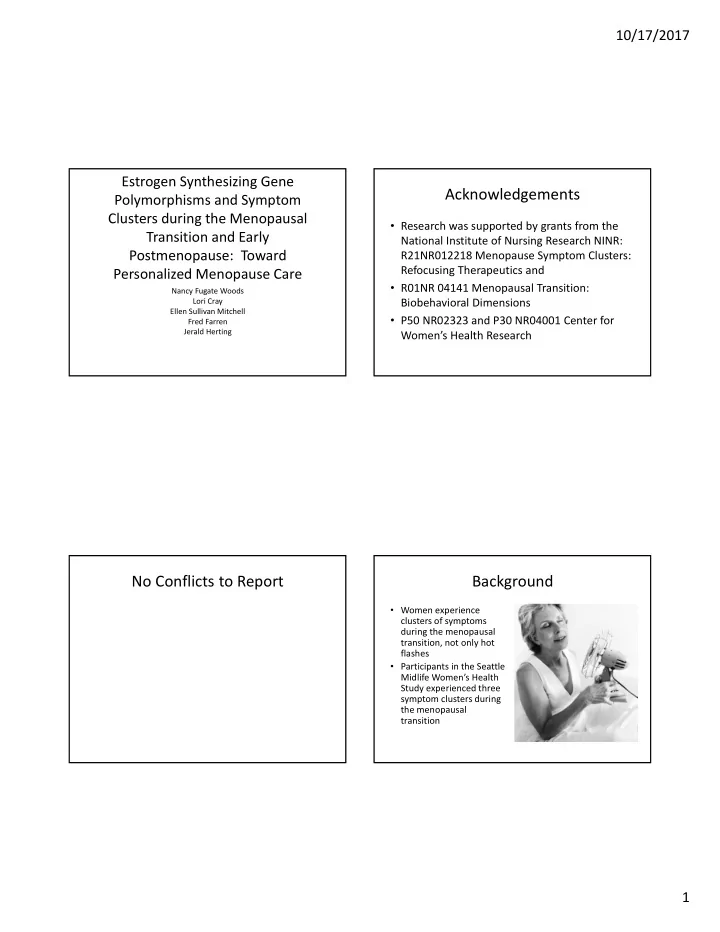

10/17/2017 Estrogen Synthesizing Gene Acknowledgements Polymorphisms and Symptom Clusters during the Menopausal • Research was supported by grants from the Transition and Early National Institute of Nursing Research NINR: Postmenopause: Toward R21NR012218 Menopause Symptom Clusters: Refocusing Therapeutics and Personalized Menopause Care • R01NR 04141 Menopausal Transition: Nancy Fugate Woods Lori Cray Biobehavioral Dimensions Ellen Sullivan Mitchell • P50 NR02323 and P30 NR04001 Center for Fred Farren Jerald Herting Women’s Health Research No Conflicts to Report Background • Women experience clusters of symptoms during the menopausal transition, not only hot flashes • Participants in the Seattle Midlife Women’s Health Study experienced three symptom clusters during the menopausal transition 1
10/17/2017 Symptom Clusters during the Menopausal Transition and Symptom Clusters: Correlates Early Postmenopause • Cluster 1 was associated with the late menopausal transition stage and early postmenopause (Cray et al, 2012) and with lower urinary estrone and higher FSH levels (Woods et al, 2013) • Gene polymorphisms associated with estrogen synthesis genes (CYP 19, 17 HSDB1) are of interest as biomarkers, e.g. CYP 19 11r associated with higher estrone levels (Woods 2007) Cluster 1 Cluster 2 Cluster 3 Cray et al, 2012 Gene Polymorphisms and Symptom Clusters Sex Steroid Pathways: Estrogens Estrogen Synthesis: CYP 19 – aromatase gene 17 HSDs SC1=high HF SC2=low HF, Estrogen moderate others SC3=low severity Metabolizing: CYP1A1, CYP 1B1 Estrogen Receptors: ESR1, ESR2 2
10/17/2017 Methods: Seattle Midlife Women’s Aim Health Study Assess the associations between estrogen synthesis gene (CYP 19 & 17 HSD) polymorphisms and the three symptom clusters – CYP 19 repeats (TTTA)n – 7r, 7r ‐ 3, 11r (tetranucleotide repeat polymorphisms) and rs 10046 (C/T) – 17HSDB1 rs2830 (A/G), rs592389 (G/T) , rs 615942 (T/G) Study Design – Seattle Midlife Genotyping Women ’ s Health Study • Buccal swab samples were genotyped by the • Longitudinal study with 508 women interviewed between 1990-1992 (screened over 11,000 Center for Ecogenetics and Environmental households from multi-ethnic census tracts) Health at the University of Washington using • Annual follow-up since enrollment with 390 women polymerase chain reaction primers and allele starting longitudinal study in 1992 specific probes • Cohort included 243 participants in 1996 when • CYP 19 7r, 7r ‐ 3, 11r TTTAn (rs2389) and rs monthly urine samples were added to study and in 10046 (C/T) 2000 193 provided buccal swabs for genotyping • 17 HSD (rs2830 (A/G, GG), rs592389 (G/T, TT), • Women had 16 years of education, 85-91% rs615942 (C/A, AA) employed, 75-89% white, and 68-69% partnered 3
10/17/2017 Identifying Symptom Clusters: Latent 3-day health diary Class Analysis • Latent class (or latent mixture) model empirically determines whether there are distinct clusters (latent classes) of symptoms • Does not assume linearity, normally distributed data, or homogeneity of variances • LCA (Mplus v. 5) was used to find clusters (latent classes) of MT symptoms • Gene polymorphisms include as covariates to assess effect on symptom cluster membership Polymorphisms and Symptom Clusters: Results Cluster 1 vs 3 • 17 HSD rs 592389 (G/T) and rs 615942 (T/G) were Polymorphism b SE Wald(1)/ OR associated with lower likelihood of having cluster 1 vs 3 • 17 HSD rs 592389 (G/T) and rs 615942 (T/G) were CYP 19 rs .138 .800 0.17 also associated with higher estrone levels (p<.05, 10046 (C/T) 1.2 .10) 17 HSDB1 1.92 0.54 3.55** • CYP 19 repeat/deletion and rs 10046 (C/T) 615942 (T/G) 6.8 polymorphisms had no significant effects on 17 HSDB1 ‐ 0.059 0.58 ‐ 1.02 symptom cluster membership 2830 (A/G) 0.6 • None of the estrogen synthesis polymorphisms 17 HSDB1 2.30 0.49 4.72** differentiated symptom clusters 2 and 3 592389 (G/T) 10.0 4
10/17/2017 Discussion and Conclusions Conclusions • Women with Symptom Cluster 1 (high hot flash • Based on our studies, Symptom Clusters 1 and 3 group) were less likely to have the can be distinguished by: polymorphisms for 17 HSDB1 rs2389 (G/T) and rs – Menopausal transition stages, E1G and FSH 615942 (T/G) polymorphisms than those in – Perceived stress Cluster 3 (low severity symptoms) – Epinephrine and norepinephrine • Association of the 17 HSDB1 rs 592389 and rs – Gene polymorphisms related to estrogen synthesis (17 615942 genotypes with higher estrone levels HSDB1 rs 592389 and rs 615942) makes the relationship plausible • Replication of findings relating symptom clusters to estrogen synthesizing genes needed in larger • No other polymorphisms were significantly and ethnically diverse populations related to Symptom Clusters Thank you for your interest in women’s health! 5
Recommend
More recommend